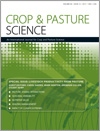
Crop and Pasture Science
Volume 68 Number 12 2017
Livestock Productivity from Pasture
CP16375Grazing management of dairy pastures based on tall fescue in southern Australia
Six grazing-management treatments were applied for 3 years to a tall fescue–white clover pasture in northern Victoria.A grazing regime based up the 3-leaf stage resulted in 30% higher dry matter removal, higher tall fescue content and greater plant persistence compared to the most frequently grazed treatments.The practicality of this approach to grazing tall fescue needs to be tested at the whole-farm level.
CP16383Use of sensor-determined behaviours to develop algorithms for pasture intake by individual grazing cattle
Practical and reliable measurement of individual pasture intake will improve precision in livestock and pasture management, provide input data for prediction and simulation models, and allow animals to be ranked on grazing efficiency for genetic improvement. We used sensors to determine pasture intake of individual grazing cattle. Grazing behaviour classified using data from collar-mounted sensors, and benchmark pasture-intake data, allowed establishment of initial pasture-intake algorithms for use with sensors.
CP16385Quantifying the interactions between defoliation interval, defoliation intensity and nitrogen fertiliser application on the nutritive value of rainfed and irrigated perennial ryegrass
A 2-year experiment was undertaken at Elliott Tasmania to quantify the interactions between defoliation interval, intensity, nitrogen fertiliser and irrigation. While defoliating to 3 mm at the 1-leaf stage did statistically increase the concentration of crude protein and lower in the concertation of fibre in the pasture, these improvements were biologically minimal. Perennial ryegrass pastures should be defoliated at the 3-leaf stage to approximately 55 mm as this will maximise production and persistence.
CP16395Enhancing composition and persistence of mixed pasture swards in southern New South Wales through alternative spatial configurations and improved legume performance
The study examined whether the productivity and persistence of mixed pastures were improved if species were spatially separated rather than being sown together in each drill row. Results of the present study were highly site-specific, or season-dependent, but subterranean clover regeneration was consistently improved where it was spatially separated from lucerne. There were fewer consistent benefits of alternative spatial configurations on swards containing phalaris with subterranean clover or with lucerne.
CP16396Better management of intensive rotational grazing systems maintains pastures and improves animal performance
This paper examines how the management of intensive rotational grazing systems influences pasture composition, diet quality and livestock performance. There was substantial opportunity to enhance the production of intensive rotational grazing systems through fast rotations at a high stocking rate. Intensive rotational grazing can be managed flexibly to improve animal performance by using green herbage allowance, with higher allowances needed as feed quality declines.
CP16405An initial investigation of forage production and feed quality of perennial wheat derivatives
A redesign of agricultural production away from annual grain crops to a system that utilizes perennial grain crops, offers an opportunity to improve sustainable grain production and food security into the future. An important component in this redesign will be the profitable integration of livestock into the system through grazing. This study demonstrates that early generation perennial grain crops can be used as successful dual purpose crops and deployment of commercial cultivars may soon be at hand.
CP16379Does establishing lucerne under a cover crop increase farm financial risk?
In the south-west slopes region of NSW, Australia, there is little financial difference between sowing lucerne alone or under a cover crop at low stocking rates (<10 dry sheep equivalents/ha). Sowing lucerne alone gives farmers the option to run higher stocking rates for higher median decadal cash margins without additional financial risk; however, the high variability around the medians can mask these differences in the short term.
CP16379 Abstract | CP16379 Full Text | CP16379PDF (365 KB) Open Access Article
CP16394The impact of extreme climatic events on pasture-based dairy systems: a review
The productivity and profitability of Australia’s dairy are highly susceptible to climate change and extreme climatic events. We provide an insight into Australian dairy systems and present the existing and most relevant scientific literature on the impact on pastures and animals, outline adaptation and mitigation strategies and highlight important research gaps.



